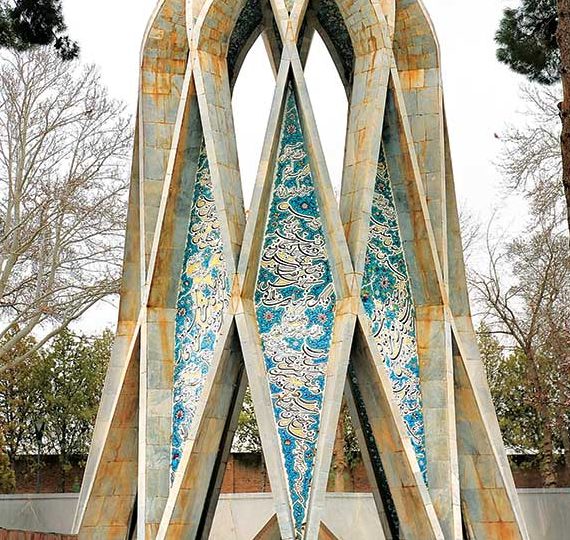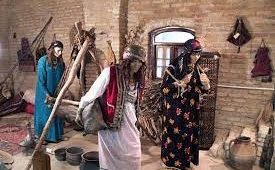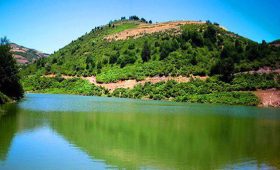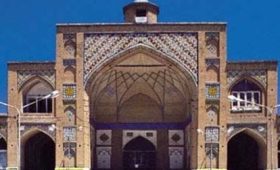Hakim Abul Fatah Umar Ibn Khayyam Nishaburi Astronomer, Mathematician, Scientist and Great Thinker, was born in the early 5th century of Hijri and during the reign of Sultan Sanjar, he treated Malik Shah’s son who was suffering from smallpox. Although Khayyam’s scientific status is considered much higher than his literary status, his fame is mostly due to the existence of his wise quatrains.
The tomb of Hakim, Abul Fatah Umar ibn Khayyam Nishaburi, is one of the sightseeing places of Nishabour in Razavi Khorasan Province. This place, that is visited by a large number of domestic and foreign lovers and tourists every year, is located in the southeast of Neishabur city and at the end of Khayyam Street. Khayyam complex, which includes a museum and a tomb, is one of the tourist attractions of Razavi Khorasan province.
After the death of Omar Khayyam, his body was buried in the central cemetery of Hira Neishabur, that did not have a special tomb and was placed in a porch-like chamber on the eastern side of the Muhammad Mahrooq Mosque. From the time of Khayyam’s death in 510 A.D. until 1335, the building of his tomb was in ruins until the people invited to the opening ceremony of Ferdowsi’s tomb, who were going to Tus, visited this tomb on the way. Then the proposal to rebuild this building in a better and more worthy way was proposed; therefore, at the same time as Ferdowsi’s Millennium celebration, the National Artifacts Association built a tomb for Khayyam.
Engineer Hoshang Sihun, who was the supervisor of the National Antiquities Association’s constructions at that time, along with Hossein Jodet, moved the tomb from the previous location, which was attached to Imamzadeh Mahrouq, to the current location. In 1338, the construction of the mausoleum began, and in this year, the major parts of the work, including excavation, concreting of the building and the design of the area, were implemented. In 1341, the construction of the tomb was finished. The tomb and its main ossification is metal surrounded by concrete cover. The shape of the building has 10 divisions at the bottom and the distance between the foundations is five meters.
This mausoleum was built in the form of a square platform and an open stone building, which was placed next to the mausoleum and mosque of Mohammad Mahrooq. This tomb consisted of two upper and lower porches and a short stone wall made of khalij stone that was used around the grave and on the grave that was three or four meters away from the tomb wall. And also a stone pillar with a quatrain of Malik al-Shaarai Bahar was engraved on it with Nastaliq script.
The area of Bagh Khayyam is 20,000 square meters and the length of the mesh monument is 18 meters, and it is surrounded by evergreen pines. The mausoleum building is made of iron and stone in the form of a lofty dome with 10 bases, and its bases are connected to each other with geometric shapes and large and small rhombuses. Around the base of the dome, there are pyramids of large stones and stone fountains, which are tiled inside. Khayyam’s tomb is one of the prominent buildings designed in Iran, that has displayed a successful combination of traditional and modern elements. Professor Hoshang Sihon himself says about this building:
Khayyam actually has three characters, a mathematician, an astrologer and a poet, all three characters should have been shown in the building.
Around the tower, next to the fountains, a wide circle was built in the center of the tower itself. All of them are made of granite with triangular elements and indentations and protrusions that to some extent evoke the shape of a tent, and this is a reference to Khayyam’s name. Because his father was a tent maker and his name was chosen for this occasion.
The floor circle is divided into 10 parts so that the memorial tower is based on 10 bases. The number 10 is the first two-digit number in mathematics and is the basis of many numbers. From each of the foundations, two diagonal blades move upwards in such a way that the total volume of the tower is created by the intersection of these blades, and because the blades are diagonal, their horizontal lines must face the vertical axis of the tower. The sides of the building are indented in the form of regular geometric shapes, and then they form a quasi-dome at the top in an almost conical shape.
Finally, a five-pointed star completes them, which is reminiscent of the star that is considered the symbol of Khayyam’s scientific and astronomical personality. The blades move upward in a spiral shape to intersect and come out on the other side, which itself is a complex mathematical and geometrical shape. This figure and the number 10 are both symbols of Khayyam’s mathematical knowledge.
The interior and exterior of the tomb are decorated with mosaic tiles and Khayyam’s poems. The quatrains were chosen by master Jalal Homai and the beautiful writings were done by Morteza Abdur Rasouli. In the history of Iranian architecture, this was the first time that Nastaliq script was used in the decoration of a building. From the inside, these rhombuses are full of poetry with flower, leaf and ivy patterns, decorated with mosaic tiles, and they all refer to the personality of the poet Khayyam.
This work was done under the supervision of the designer and architect of the building, Engineer Sihoun, and it is considered a unique example of the use of the suspension line in the inscriptions of the buildings. Although the suspension line is forgotten today, it is the first Iranian line and was widely used among scribes during Khayyam’s time. The facade of the building is stone masonry and is made with thin pieces of strong and transparent stones.
Next to the mausoleum, there are seven very beautiful stone tents, under each of which there is a water basin with turquoise colored tiles. Hoshang Sihun says about this:
On the other hand, the ponds with turquoise tiles, which show a part of the star in total, are seven feathers in the concept of seven heavens and seven hills, referring to the heavens and astronomy, another knowledge of Khayyam. All in all, the complex was built in a poetic mood with stout trees around it, and as Khayyam himself wished, it is completely open and his tomb blooms in the spring.
Khayyam’s tomb is one of the most important buildings built in its time in terms of architecture and construction. This magical building is calculated and designed based on Khayami’s mathematical and trigonometric principles. A walk in the corridors and vaults and porches of the tomb is a journey to the infinite world of Khayyam’s meanings. The tomb of Hakim Omar Khayyam was registered in the list of national works of Iran by the Ministry of Culture and Arts.




